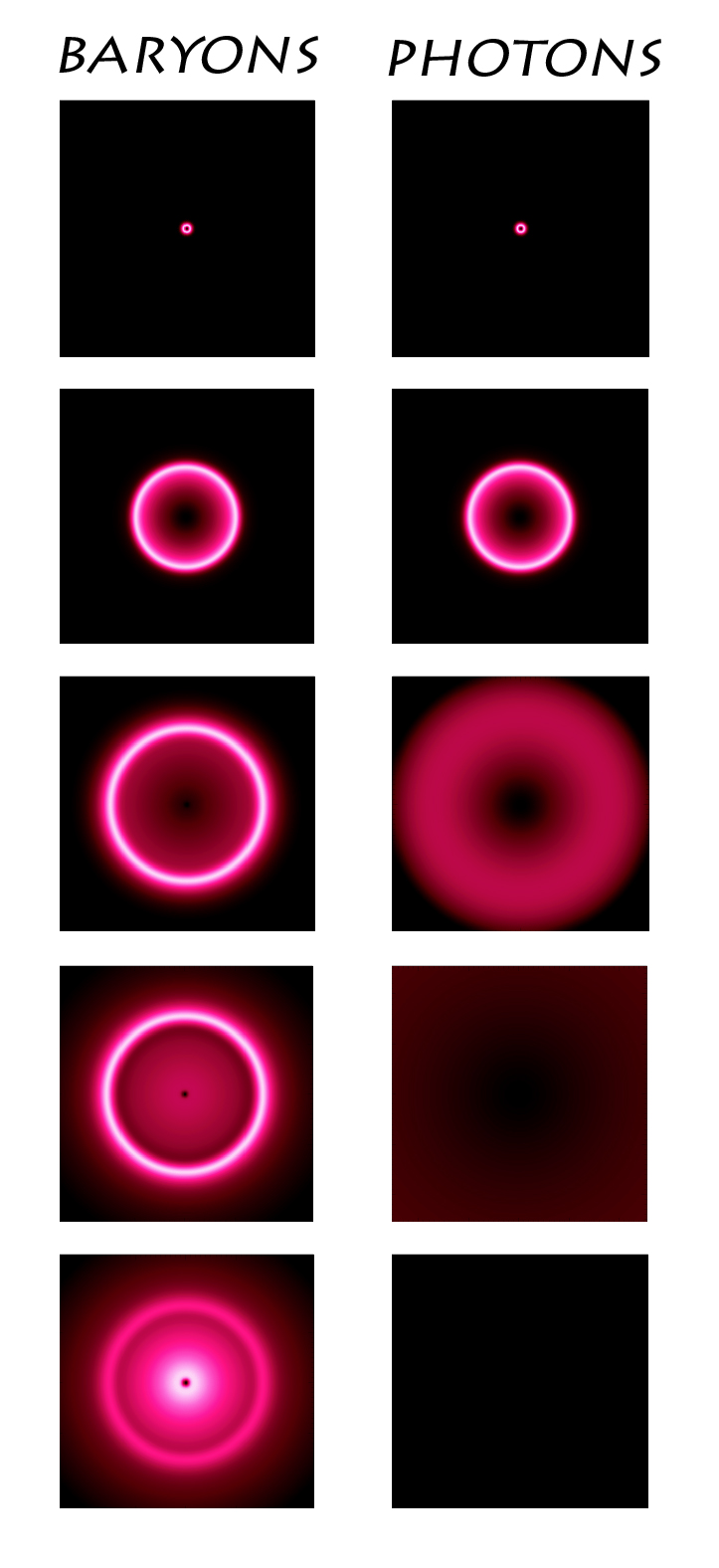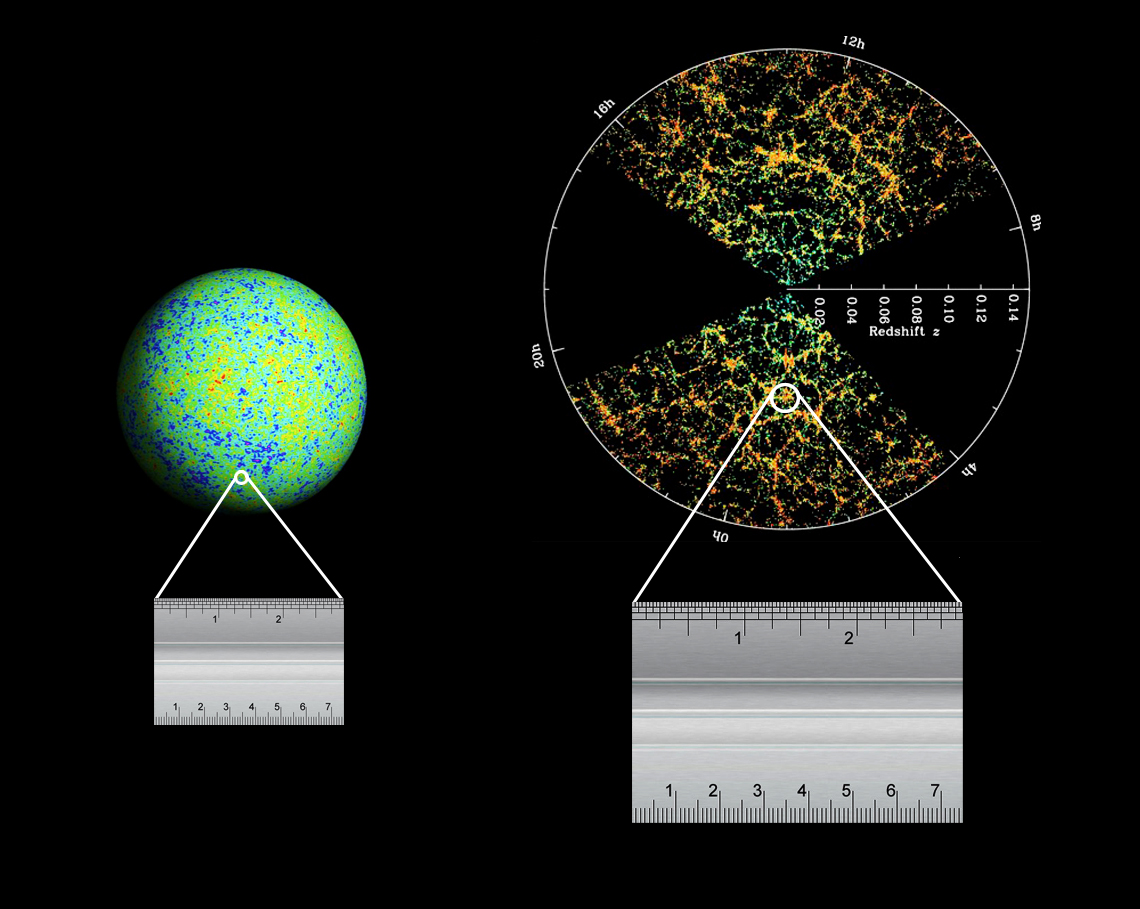Contact: Paul Preuss

Up until about 400,000 years after the big bang the Universe was a liquid-like plasma of protons and electrons (“baryons”) in which photons of light were trapped; dark matter was also part of the mix. Imagine a single perturbation, like a stone dropped in a pond: baryons and photons ripple outward togther, traveling through the plasma in a sound wave. But when the Universe cooled enough for protons and electrons to recombine, it became transparent and the photons escaped, while the baryons, with nothing left to push them, stayed in place. The original perturbation and its echo form a unit on the baryon acoustic oscillation ruler. (Images from an animation by Martin White.)
If dark energy is real and not a flaw in our understanding of gravity, then the best way to understand it is by studying the expansion history of the Universe, according to Martin White, an astrophysicist at Berkeley Lab and a professor of astronomy and physics at UC Berkeley. “One way is with ‘standard candles’ – that is, supernovae,” White says. “Another way is with a ‘standard ruler.’”
Baryon acoustic oscillation, or BAO, may provide the ideal standard ruler. The scale is calibrated by the cosmic microwave background (CMB), which recorded the state of the Universe roughly 400,000 years after the Big Bang. At this early epoch, the standard ruler for BAO is detectable as periodic, minute variations in the temperature of the CMB. More recently, the ruler’s scale is evident in the regular clustering of galaxies and intergalactic gas, and is also present in the clumping of invisible dark matter. These oscillations can be measured both across the sky and in the line of sight (back in time).
Both signals have the same origin. The early universe was a liquid-like plasma of protons and electrons in which light was trapped, with dark matter also part of the mix. “Baryons” (ordinary matter) moved in “acoustic oscillations” (sound waves) through the plasma. When the Universe cooled enough for the protons and electrons to combine into hydrogen atoms, the photons were freed and the Universe became transparent. The dark matter stayed invisible, but variations in density left their mark in the CMB and were the seeds of large-scale structure in today’s universe, such as clusters of galaxies.
The first clear detection of a BAO signal was announced in 2005 by Daniel Eisenstein of the University of Arizona and his colleagues, who analyzed data from about 50,000 luminous red galaxies in the Sloan Digital Sky Survey (SDSS), plus some from a separate survey by the Two Degree Field Galaxy Redshift Survey based in Australia.
In a paper published in July 2007, Nikhil Padmanabhan, David Schlegel, and Uroš Seljak, all by then at Berkeley Lab, presented their work with colleagues in SDSS and members of the Australian survey to extend the analysis to 600,000 luminous red galaxies at distances up to 5.6 billion light-years. This report benefited from exploring the largest volume of space ever used for galaxy clustering measurements – approaching halfway back in time to the origin of the CMB. Although the survey did not depend on the redshifts of individual galaxies (instead estimating distance on the basis of the specific colors of the galaxies), it was able to establish a specific scale for the markings on the standard ruler: 450 million light-years.
“Unfortunately it’s an inconveniently sized ruler, to put it mildly,” says Schlegel, a staff scientist in the Physics Division. “We had to sample a huge volume of the Universe just to fit the ruler inside.”
Big as the map was, and important as it was in establishing the real possibility of using the BAO standard ruler to measure the expansion history of the Universe, precision measurements were still a long way off. “We showed there was an effective ruler,” says Schlegel. “Now we had to use it.”
That effort got underway in September 2009, when the Baryon Oscillation Spectroscopic Survey, BOSS, recorded “first light” in what will be a five-year search to record the individual spectra of two million galaxies and quasars, plus variations in the density of the intergalactic gas, across a quarter of the entire sky. The oscillations of these “baryons” in many different forms, revealed in the periodicity of the large-scale structures of the Universe, will establish the accuracy of the cosmic ruler to a precision of one percent.

The scale of variations in the cosmic microwave background and in the large-scale structure of the Universe constitute a ruler by which to measure the Universe's expansion history. (Images courtesy NASA’s Wilkinson Microwave Anisotropy Probe, left, and Sloan Digital Sky Survey, right. Click on image for best resolution)
BOSS is the flagship survey of the third phase of the Sloan Digital Sky Survey, known as SDSS-III, which is headed by Daniel Eisenstein. Among other Berkeley Lab contributors to the collaboration, Schlegel is the principal investigator for BOSS, White is its survey scientist, and Natalie Roe of Berkeley Lab’s Physics Division is its instrument scientist.
The correlated results from supernovae and BAO measurements will home in on the expansion history of the Universe and make it possible to differentiate among the competing theories of its nature. But what if dark energy is an illusion, and what we take as evidence for dark energy is really just a flaw in our understanding of gravity?
Another technique, which relies upon the idea that large amounts of mass — whether visible or invisible — can distort our view of the light waves from even more distant objects beyond in known ways, may be the answer.
One way to find out is to measure the growth of structure in the Universe by means of weak gravitational lensing. Read on>
Additional information
The principles behind baryon acoustic oscillation are explained by Martin White at http://astro.berkeley.edu/~mwhite/bao/